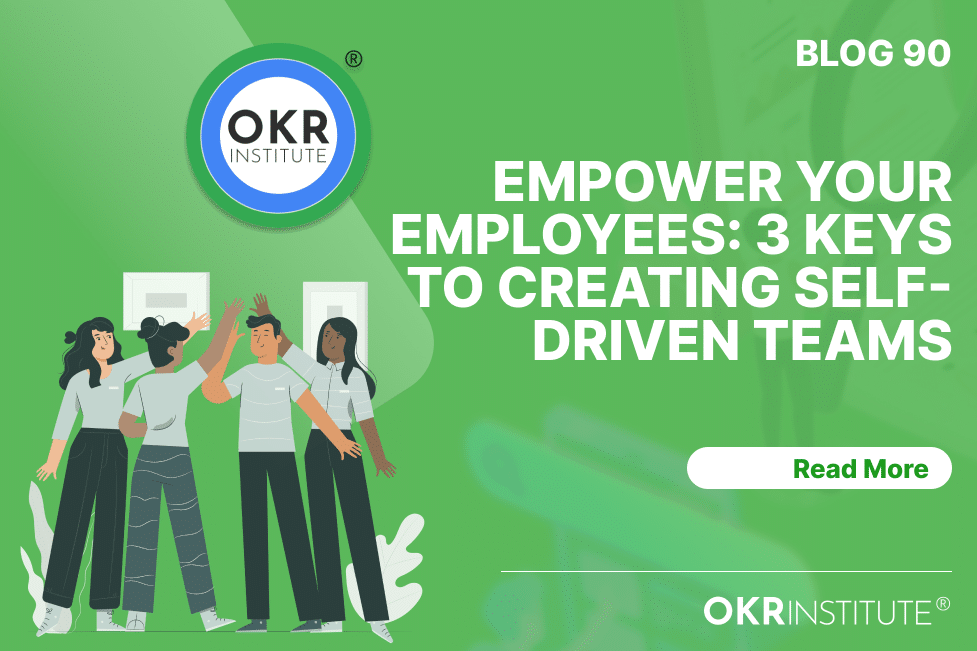How to bridge the strategy and execution gap with Okrs

How to Bridge the Strategy and Execution Gap with OKRs
The use of OKR frameworks has become prevalent and, in more and more organizations, they have become a ‘best practice.’ In part, OKRs are favored due to the role it plays in bridging the strategy and execution gap when effectively deployed.
Some Organizations with few remaining resources are better off first seeking ‘small wins’ to regain momentum after a sustained and extended period of poor performance before going after ‘stretch goals.’ Per Daniel Kahneman and Amos Tverskys’ research, failure tends to put decision-makers in a risk-seeking frame of mind. They gamble on ‘stretch goals’ without the resources or sufficient knowledge to pull them off.
‘Stretch Goals’ are hard to actualize:
- Resources, both financial and human, have to be considered
- Stretch goals are frontiers beyond the known and ‘business as usual.’
- It is a considerable risk to attempt to achieve stretch goals in isolation without aligning it to the culture of the organization
- A strong traditional orientation and culture is not an optimal environment for stretch goals
Yet, it can be the most worthwhile endeavor for any company: – When correctly deployed, stretch goals:
- Have several motivating mechanisms to it
- Uplifts the engagement levels of employees
- Increases the company’s innovation rate
- Adds tremendous value to customers/clients /users
- Fosters creativity, inclusion, and collaboration
- Breaks the silo effect and hierarchies
- Can genuinely differentiate a company from competitors
Why do people not take action on strategies?
A study by MIT Sloane revealed that:
At the highest level of a company, on average, only 51% know and understand the company’s strategies. At the senior executive level, it is significantly lower, at 22%; at the middle management level, it is as low as 18%; and at the frontline supervisor level, it is as low as 13%.
It is not worthwhile to ‘kick off’ a discussion on the ‘knowing-doing gap’ without ensuring that more and more company team members know the company’s strategies and how their respective roles impact those very same strategies.
In addition to the above, there is often a significant gap in the orientation and thinking of those who create the strategies and those who have to implement them. In many cases, those who conceive plans have a broader perspective (bigger picture thinking orientation), and those who execute have a narrower view (How are we going to do this?). One direction is not better than the other, yet misunderstandings and misperceptions can occur on a large scale, preventing execution if these two orientations are not reconciled.
Strategizing and communicating do not ensure execution.
Having a strategy or strategies, even brilliantly conceived ones ensures nothing. Communication also offers no assurance that anything will be done – It is a combination of factors that makes execution highly likely.
When team members feel they are part of the strategy creation from the onset and are consulted, they are more likely to bring it to fruition. The ‘IKEA effect’ is relevant in this regard.
The IKEA effect, named after everyone’s favorite Swedish furniture giant, describes how people value an object more if they make (or assemble) it themselves. More broadly, the IKEA effect speaks to how we tend to like things more if we’ve expended effort to create them.
When we as team members had assisted in creating strategies and were consulted before plans were made, we are much more likely to take ownership of the same processes and act on them.
Simplicity
‘Leaders are almost always great simplifiers.’
Colin Powell
If we cannot develop ‘easy to execute’ strategies or at least break down complex systems into much simpler ‘chunks,’ we are at high risk of execution not happening at all. When an outsider reads your strategy or strategies, it must make sense -when a system is genuinely transparent and broken down into core thematic goals or pillars and further distilled into simplified OKR frameworks, it is much more likely to be executed.
‘Eat an elephant’ says Africans to those who experience overwhelm, hypothetically speaking, of course – when your task is to eat an elephant, the only way to do it is piece by piece. When faced with an enormous undertaking, start with things you can easily do.
Why OKRs can ‘fill the strategy and execution gap.’
Within effective OKR frameworks, the company’s vision is distilled into strategic objectives, and team objectives are aligned with the strategic objectives. Key results are the ‘guidance metrics to actualize the goals. The OKR action plan contains actions, tasks, initiatives, and projects that support the Key results – Within an OKR framework, execution is already built into the flexible structure.
A strategy that is ‘smart’ to use from the onset within an organization to ensure the execution of OKRs is to ‘create’ as many OKR champions as possible – Offer an immersive experience of OKRs to those who are going to deploy them. It is a case of empowering them to draft powerful OKRs and becoming advocates for OKRs and other Agile practices within your organization.
Join our OKR Practitioner course to learn more about aligning and drafting powerful OKRs:
OKR Practitioner Course
Talent Development Director of the OKR Institute
Related Courses
Recent Posts
Tags
#OKR
#OKR Coaching
#OKR Coach







